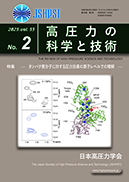Volume 33, Issue 2
Displaying 1-12 of 12 articles from this issue
- |<
- <
- 1
- >
- >|
Foreword
-
Article type: Foreword
2023Volume 33Issue 2 Pages 67
Published: June 01, 2023
Released on J-STAGE: March 29, 2024
Download PDF (279K)
Reviews - Analyses of the Pressure Effects on Protein Molecules at the Atomic Level -
-
Article type: Review
2023Volume 33Issue 2 Pages 69-75
Published: June 01, 2023
Released on J-STAGE: March 29, 2024
Download PDF (1430K) -
Article type: Review
2023Volume 33Issue 2 Pages 76-82
Published: June 01, 2023
Released on J-STAGE: March 29, 2024
Download PDF (1659K) -
Article type: Review
2023Volume 33Issue 2 Pages 83-90
Published: June 01, 2023
Released on J-STAGE: March 29, 2024
Download PDF (2345K) -
Article type: Review
2023Volume 33Issue 2 Pages 91-96
Published: June 01, 2023
Released on J-STAGE: March 29, 2024
Download PDF (1039K) -
Article type: Review
2023Volume 33Issue 2 Pages 97-106
Published: June 01, 2023
Released on J-STAGE: March 29, 2024
Download PDF (2482K) -
Article type: Review
2023Volume 33Issue 2 Pages 107-115
Published: June 01, 2023
Released on J-STAGE: March 29, 2024
Download PDF (2284K)
Review: 2022 JSHPST Award
-
Article type: Review: 2022 JSHPST Award
2023Volume 33Issue 2 Pages 116-124
Published: June 01, 2023
Released on J-STAGE: March 29, 2024
Download PDF (3420K)
Review: 2022 JSHPST Award for Young Scientists
-
Article type: Review: 2022 JSHPST Award for Young Scientists
2023Volume 33Issue 2 Pages 125-132
Published: June 01, 2023
Released on J-STAGE: March 29, 2024
Download PDF (1575K) -
Article type: Review: 2022 JSHPST Award for Young Scientists
2023Volume 33Issue 2 Pages 133-138
Published: June 01, 2023
Released on J-STAGE: March 29, 2024
Download PDF (1314K)
Laboratory News
-
Article type: Laboratory News
2023Volume 33Issue 2 Pages 139-140
Published: June 01, 2023
Released on J-STAGE: March 29, 2024
Download PDF (603K)
Salon
-
Article type: Salon
2023Volume 33Issue 2 Pages 141-149
Published: June 01, 2023
Released on J-STAGE: March 29, 2024
Download PDF (9657K)
- |<
- <
- 1
- >
- >|
